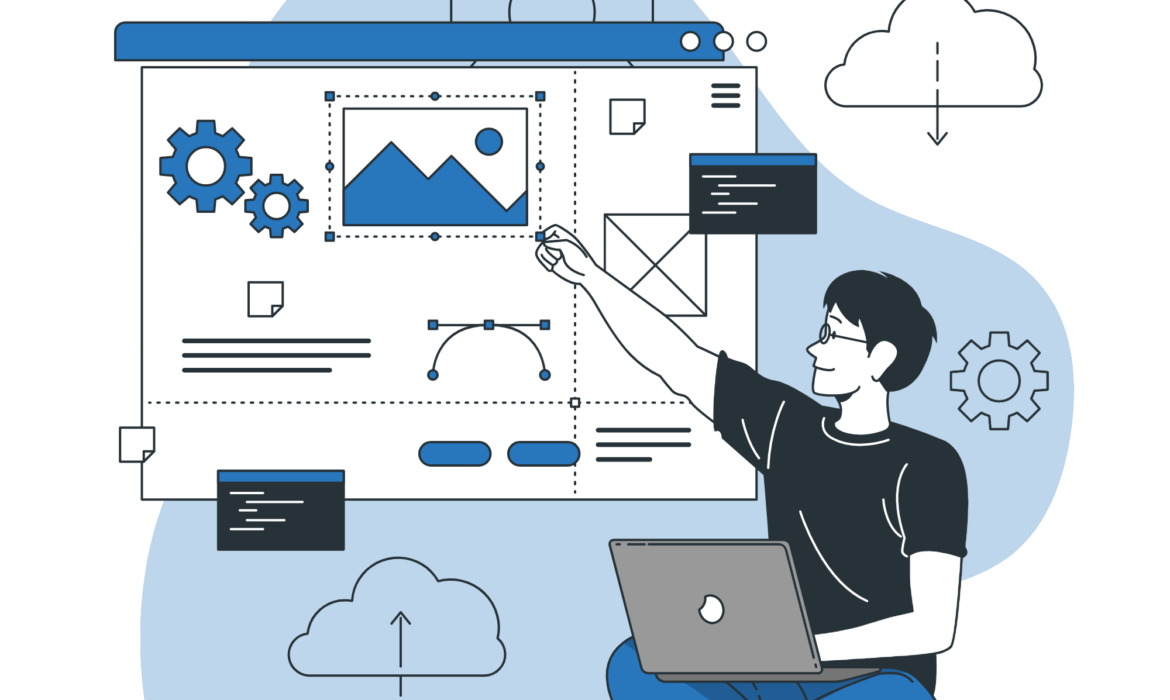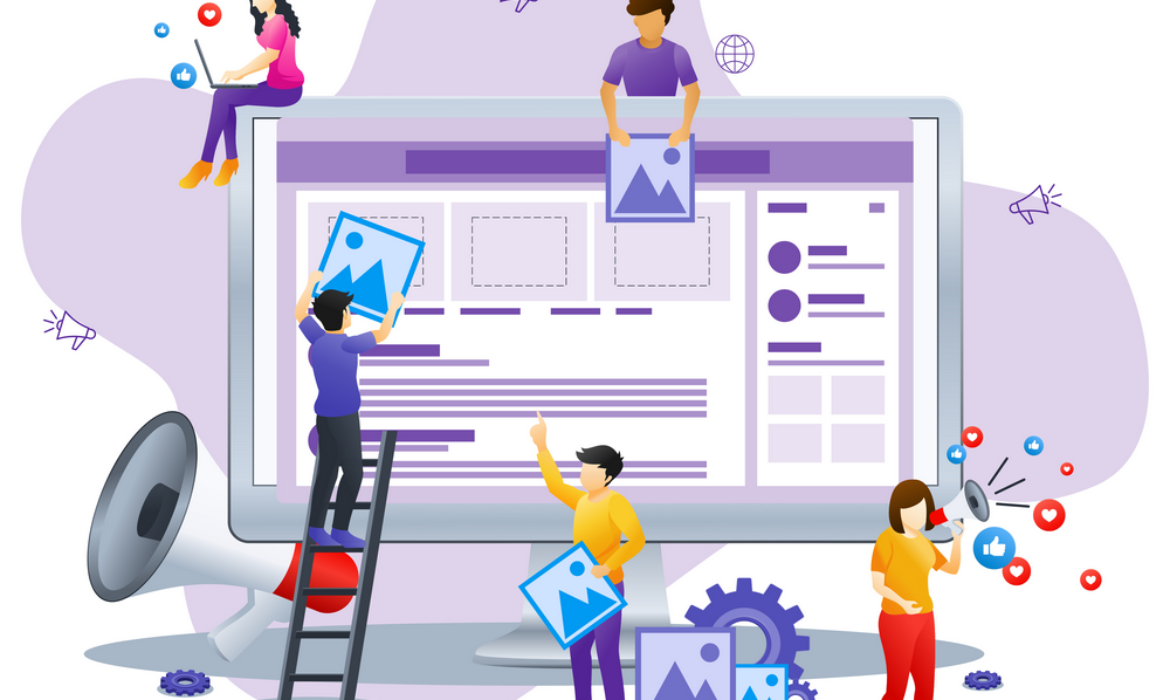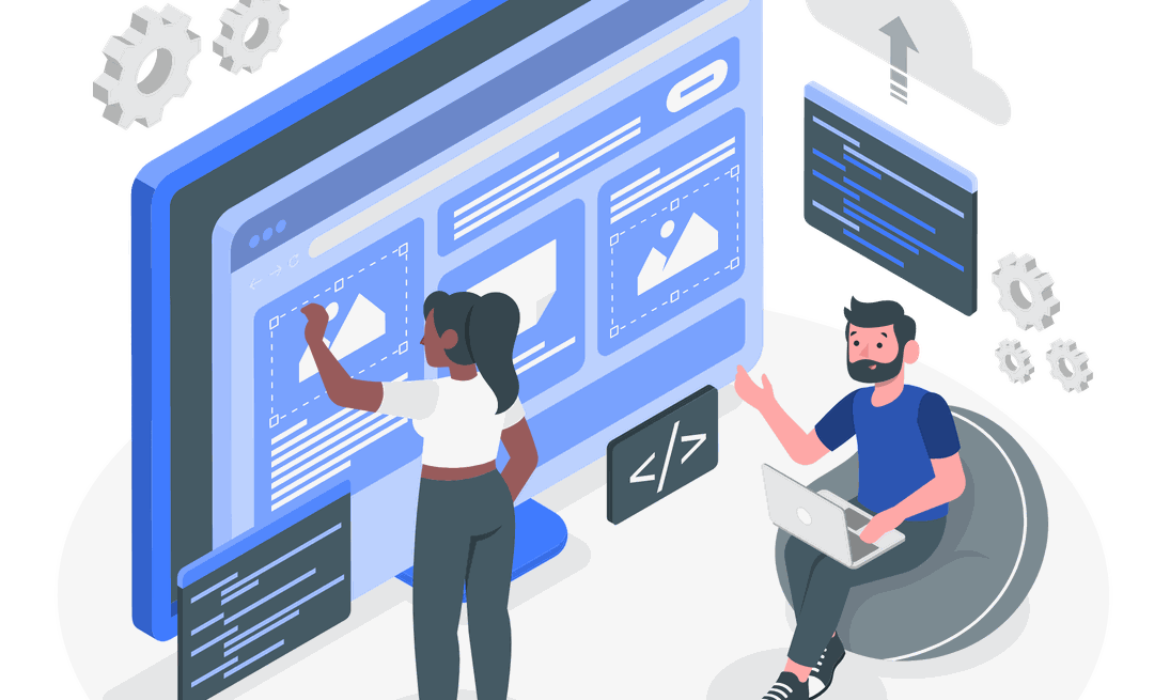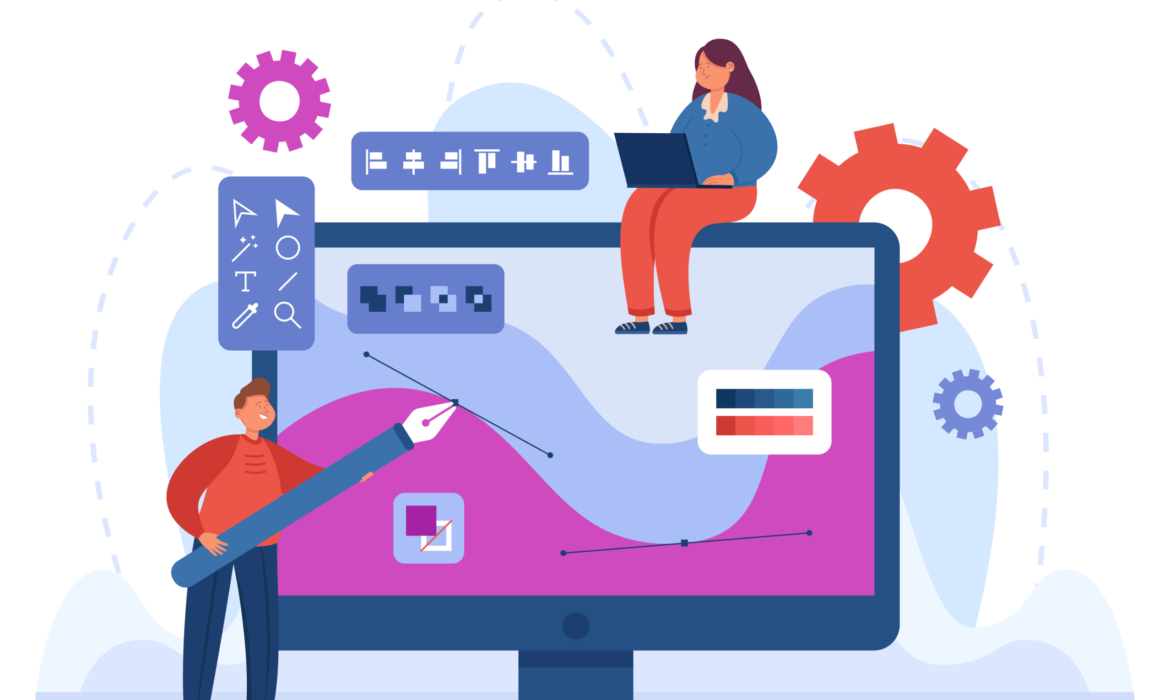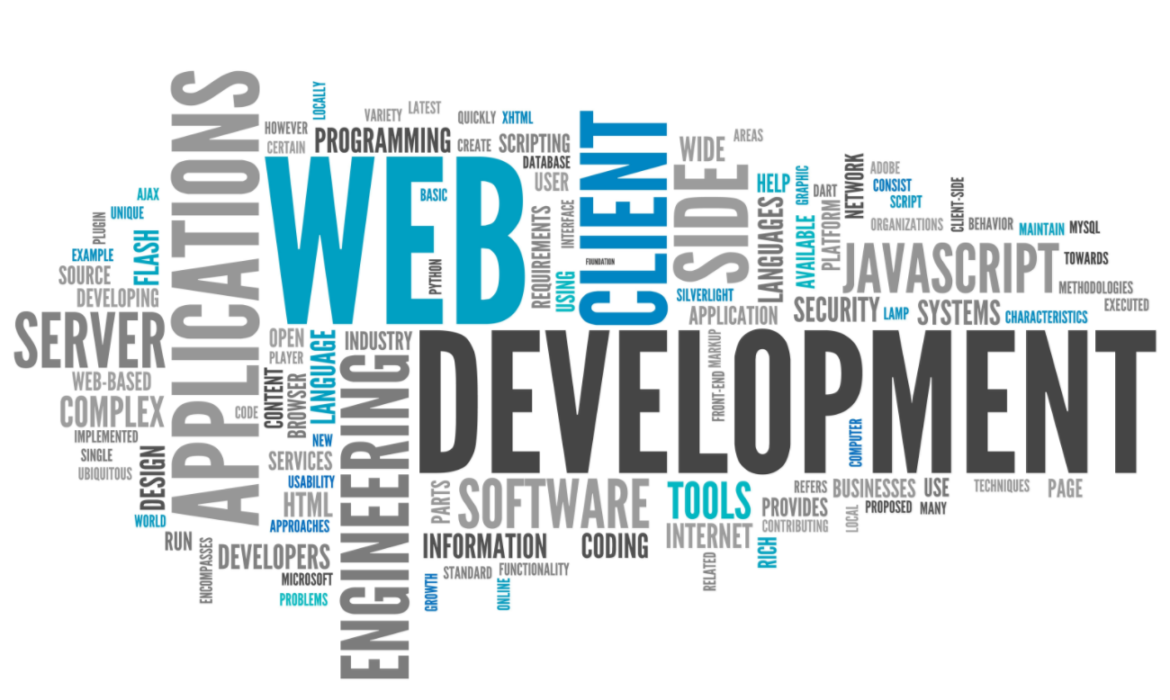Web Development for APIs: Building Connected and Integrated Applications
Introduction
In today’s interconnected world, web APIs (Application Programming Interfaces) have become the backbone of modern software development. APIs serve as intermediaries, enabling applications to communicate and exchange data seamlessly, breaking down silos and fostering a collaborative ecosystem of digital services. By adhering to well-defined standards and protocols, APIs facilitate data sharing, integration, and innovation across a wide range of applications and platforms.
Unveiling the Benefits of Web APIs
Enhanced Application Functionality: APIs allow developers to integrate external data and services into their applications, expanding their capabilities and providing users with a richer experience.
Improved Data Accessibility: APIs make data available to a broader audience, enabling developers to build applications that leverage existing data sources and insights.
Promoted Innovation and Collaboration: APIs foster a collaborative environment, allowing developers to share data, services, and functionalities, leading to innovation and new product development.
Reduced Development Time and Costs: APIs can save developers time and effort by providing pre-built functionalities and data sources, reducing the need for redundant development.
Streamlined Communication and Integration: APIs streamline communication between applications and systems, enabling seamless data exchange and integration across diverse platforms.
Essential Principles for API Design
Clarity and Simplicity: Design APIs that are easy to understand, document, and use, making them accessible to a wider range of developers.
Consistency and Predictability: Maintain consistent naming conventions, data formats, and error handling across API endpoints to ensure predictability and ease of use.
Versioning and Compatibility: Implement versioning strategies to ensure compatibility with evolving API specifications and protect users from breaking changes.
Security and Authentication: Implement robust security measures, such as authentication, authorization, and encryption, to protect sensitive data and prevent unauthorized access.
Error Handling and Graceful Degradation: Design APIs that handle errors gracefully, providing developers with clear error messages and enabling applications to recover from unexpected situations.
Practical Steps for API Implementation
Define API Scope and Objectives: Clearly define the scope of your API, identifying the data and services it will provide and the target audience it will serve.
Choose an API Design Style: Select an appropriate API design style, such as REST or GraphQL, considering factors like data structure, access patterns, and developer preferences.
Design API Endpoints and Data Formats: Define the API endpoints, request methods, and data formats (JSON, XML, etc.) to ensure a consistent and well-structured API.
Implement API Documentation: Create comprehensive API documentation that clearly explains how to use the API, including endpoints, request parameters, response formats, and error codes.
Test and Deploy Your API: Rigorously test your API for functionality, performance, and security before deploying it to a production environment.
API Integration: Connecting the Dots
Choose the Right Integration Approach: Select the appropriate integration approach, such as direct API calls, SDKs, or third-party integration platforms, considering factors like technical expertise and project requirements.
Understand API Documentation: Carefully review the API documentation to understand the endpoints, data formats, authentication requirements, and error handling mechanisms.
Implement API Authentication: Implement the necessary authentication methods, such as OAuth or API keys, to secure access to the API and protect sensitive data.
Handle API Responses and Errors: Process API responses effectively, parsing JSON or XML data and handling errors gracefully to ensure application stability.
Test and Monitor API Integration: Thoroughly test the API integration to ensure data integrity, performance, and compatibility. Continuously monitor the integration for potential issues and performance bottlenecks.
Conclusion
Web APIs have revolutionized the way applications communicate and share data, enabling a connected and integrated digital landscape. By understanding the principles of API design, implementation, and integration, developers can create powerful and user-friendly APIs that power the modern web and drive innovation across industries.
Web Development for Single-Page Applications (SPAs): Building Dynamic User Experiences
Introduction
In the realm of web development, Single-Page Applications (SPAs) have emerged as a frontrunner for creating captivating and interactive user experiences. Unlike traditional web applications that reload the entire page for each user interaction, SPAs dynamically update content without reloading, providing a seamless and fluid user experience. This approach has gained immense popularity due to its ability to enhance user engagement, improve performance, and deliver a more app-like feel to web applications.
Unveiling the Advantages of Single-Page Applications
Enhanced User Experience: SPAs offer a smoother, more responsive user experience, minimizing page loading times and creating a sense of native application-like interaction.
Improved Performance: SPAs can load and render content faster, reducing the time it takes for users to interact with the application.
Reduced Server Load: By minimizing page reloads, SPAs put less strain on the server, making them more scalable and efficient.
Offline Accessibility: With caching mechanisms, SPAs can provide limited functionality even when offline, enhancing user experience in areas with unreliable internet connectivity.
Flexibility and Versatility: SPAs can be built using various JavaScript frameworks, offering flexibility in development and catering to diverse project requirements.
Popular Frameworks for Single-Page Application Development
React: React is a JavaScript library for building user interfaces, known for its component-based approach and virtual DOM manipulation.
Angular: Angular is a TypeScript-based framework that provides a structured and opinionated development environment, ideal for large-scale enterprise applications.
Vue.js: Vue.js is a progressive JavaScript framework that prioritizes simplicity and flexibility, offering a balance between ease of use and powerful features.
Essential Best Practices for Building Single-Page Applications
Define Clear Goals and Requirements: Clearly outline the objectives of your SPA and the specific needs it aims to address.
Choose the Right Framework: Select an SPA framework that aligns with your project’s requirements, team expertise, and long-term maintainability.
Plan Your Application Structure: Organize your SPA’s architecture effectively, separating concerns and ensuring a modular and scalable codebase.
Optimize Performance: Implement performance optimization techniques, such as code minification, image optimization, and caching, to ensure a fast and responsive user experience.
Ensure Accessibility: Follow accessibility guidelines to make your SPA usable by individuals with disabilities, considering factors like screen readers and keyboard navigation.
Implement Rigorous Testing: Employ comprehensive testing strategies, including unit testing, integration testing, and end-to-end testing, to ensure the quality and reliability of your SPA.
Real-World Examples of Single-Page Applications in Action
Gmail: Google’s popular email service utilizes SPA technology to provide a dynamic and responsive user experience, enabling seamless navigation and quick transitions between emails.
Trello: Trello, a project management tool, employs an SPA approach to deliver a fluid and interactive experience for managing tasks, boards, and team collaboration.
Pinterest: The visual discovery platform Pinterest leverages SPAs to create an engaging and interactive experience for users to browse and save images and videos.
Conclusion
Single-Page Applications have revolutionized web development, offering a compelling alternative to traditional web applications. By providing a dynamic, responsive, and app-like user experience, SPAs have become the preferred choice for modern web applications across various industries. As technology continues to evolve, SPAs are poised to play an even more prominent role in shaping the future of the web, delivering exceptional user experiences and driving innovation in web development.
Call to Action:
Ready to embark on your SPA development journey and create captivating user experiences?
Our team of experienced SPA developers can guide you through the entire process, from selecting the right framework to designing a user-friendly interface and implementing performance optimization strategies.
Creating Progressive Web Apps (PWAs): The Future of Mobile Web Development
Introduction
In the ever-evolving landscape of mobile app development, Progressive Web Apps (PWAs) have emerged as a game-changer, offering a compelling alternative to traditional native mobile apps. PWAs combine the best of web and mobile technologies, delivering an app-like experience that is accessible through a web browser. This innovative approach is transforming the way we interact with mobile content, providing users with a faster, more reliable, and engaging experience.
Unveiling the Key Features of Progressive Web Apps
App-Like Installation: PWAs can be installed on mobile devices, creating an app-like icon on the home screen and allowing users to launch the app directly without the need for app stores.
Offline Access: PWAs can cache data and assets, enabling users to access content and functionality even when offline, providing a seamless experience even without an internet connection.
Push Notifications: PWAs can deliver push notifications to users, keeping them engaged and informed about updates, promotions, or important messages.
Background Sync: PWAs can perform tasks and synchronize data in the background, ensuring users stay up-to-date even when the app is not actively in use.
Responzivní design: PWAs are inherently responsive, adapting their layout and functionality to fit any screen size, ensuring an optimal user experience across various devices.
Unlocking the Benefits of Progressive Web Apps
Enhanced User Experience: PWAs offer faster loading times, smoother interactions, and offline capabilities, significantly improving the user experience compared to traditional mobile websites.
Improved App Discoverability: PWAs can be installed directly from the browser, eliminating the need for app store submissions and increasing app discoverability.
Reduced Development Costs: PWAs can be developed using web technologies, reducing development costs and simplifying the maintenance process.
Cross-Platform Compatibility: PWAs work seamlessly across various browsers and devices, eliminating the need for platform-specific development.
Enhanced Performance: PWAs leverage browser caching and service workers to optimize performance, delivering faster loading times and a more responsive user experience.
Real-World Examples of Progressive Web Apps in Action
Twitter Lite: Twitter’s PWA offers a lightweight and data-efficient alternative to the native app, providing a faster and more accessible experience for users in areas with limited internet connectivity.
Starbucks PWA: Starbucks’ PWA allows customers to order and pay for their coffee without downloading the native app, streamlining the ordering process and enhancing customer convenience.
Forbes PWA: Forbes’ PWA delivers a news-reading experience that rivals its native app, offering offline access, push notifications, and a faster loading time.
Creating Your Own Progressive Web App: A Step-by-Step Guide
Define Your PWA Goals and Target Audience: Clearly outline the objectives of your PWA and identify the user base you aim to serve.
Choose a PWA Framework: Select a suitable PWA framework, such as Workbox or Polymer, to simplify development and leverage pre-built components.
Design a User-Friendly Interface: Craft an intuitive and engaging user interface that aligns with your brand identity and provides a seamless user experience.
Implement Service Workers: Utilize service workers to enable offline functionality, push notifications, and background synchronization.
Optimize for Performance: Optimize your PWA for performance, ensuring fast loading times, minimal data usage, and a responsive design.
Test and Deploy Your PWA: Rigorously test your PWA across different browsers and devices before deploying it to production.
Embracing the Future of Mobile Web Development with PWAs
Progressive Web Apps represent a paradigm shift in mobile web development, offering a superior user experience, enhanced performance, and cross-platform compatibility.
Developing Enterprise Web Applications: Scalable and Secure Solutions
Introduction
In today’s dynamic business landscape, enterprise web applications play a crucial role in driving operational efficiency, streamlining processes, and enhancing customer engagement. These applications handle sensitive data, manage complex business logic, and support a large number of concurrent users. Building enterprise web applications requires a holistic approach that considers scalability, security, reliability, and maintainability.
Key Principles for Enterprise Web Application Development
Define Clear Requirements and Goals: Clearly define the business objectives, target users, and functional requirements of the enterprise web application.
Adopt a Scalable Architecture: Design a scalable architecture that can accommodate increasing user traffic and data volume without compromising performance. Utilize load balancing, caching, and microservices principles.
Implement Robust Security Measures: Prioritize security from the outset, implementing authentication, authorization, input validation, and encryption mechanisms to protect sensitive data and prevent cyberattacks.
Ensure High Performance and Reliability: Optimize application performance by minimizing response times, maximizing throughput, and ensuring application availability through redundancy and failover strategies.
Focus on Maintainability and Code Quality: Write clean, well-documented code that adheres to coding standards and best practices to facilitate future maintenance and updates.
Embrace Agile Development Methodology: Employ agile development methodologies to promote collaboration, incremental delivery, and continuous improvement throughout the development process.
Leverage Cloud Technologies: Consider cloud-based deployment for scalability, cost-effectiveness, and access to cutting-edge infrastructure and services.
Essential Considerations for Enterprise Web Application Security
Threat Modeling and Risk Assessment: Identify potential security threats and vulnerabilities through threat modeling and risk assessment exercises.
Secure Coding Practices: Follow secure coding practices to prevent common coding errors and vulnerabilities that could lead to security breaches.
Regular Security Testing and Penetration Testing: Conduct regular security testing and penetration testing to identify and address security weaknesses before they are exploited.
Data Encryption and Access Control: Implement data encryption at rest and in transit to protect sensitive information. Enforce strict access control mechanisms to restrict unauthorized access to data and resources.
Incident Response Planning and Disaster Recovery: Establish an incident response plan to effectively handle security breaches and a disaster recovery plan to ensure business continuity in case of outages or disruptions.
Stay Updated with Security Patches and Updates: Regularly apply security patches and updates to operating systems, software components, and frameworks to mitigate emerging security threats.
Benefits of Cloud-Based Deployment for Enterprise Web Applications
Scalability and Elasticity: Cloud platforms provide on-demand scalability, allowing resources to be provisioned and scaled up or down based on changing demands.
Cost-Effectiveness: Cloud deployment can reduce infrastructure costs by eliminating the need for upfront hardware purchases and maintenance.
High Availability and Disaster Recovery: Cloud providers offer robust infrastructure and disaster recovery capabilities to ensure application availability and data protection.
Access to Cutting-Edge Technologies: Cloud platforms provide access to the latest technologies and services, enabling innovation and agility.
Reduced IT Maintenance: Cloud providers handle infrastructure maintenance, freeing up IT teams to focus on core application development and business-critical initiatives.
Conclusion
Developing enterprise web applications requires a comprehensive approach that encompasses scalability, security, performance, and maintainability. By adhering to the principles and best practices outlined in this guide, organizations can create robust, reliable, and secure web applications that empower their businesses to thrive in the digital era. Leveraging cloud technologies can further enhance scalability, cost-effectiveness, and access to cutting-edge innovation.
Call to Action:
Ready to build a scalable, secure, and high-performing enterprise web application for your business?
Our team of experienced enterprise web developers can guide you through the entire process, from requirements gathering and architecture design to implementation, security hardening, and cloud deployment. We’ll work closely with you to understand your unique business needs and challenges, ensuring your enterprise web application is tailored to achieve your strategic objectives. Contact us today to unlock the transformative power of enterprise web applications for your organization!
E-commerce Web Development: Building High-Performing Online Stores
Introduction
In today’s digital age, e-commerce has revolutionized the way businesses operate and consumers shop. Building a successful e-commerce website requires careful planning, strategic execution, and a deep understanding of customer behavior. This guide will equip you with the knowledge and insights to create an e-commerce store that not only attracts customers but also converts them into loyal patrons.
Essential Steps in E-commerce Web Development
Define Your E-commerce Goals and Target Audience: Clearly define your business objectives, target market, and the unique value proposition your e-commerce store will offer.
Choose an E-commerce Platform: Select an e-commerce platform that aligns with your business needs, technical expertise, and budget. Popular options include Shopify, WooCommerce, Magento, and BigCommerce.
Plan Your Website Structure and Navigation: Create a user-friendly website structure that allows customers to easily find the products they seek. Utilize intuitive navigation menus and well-organized categories.
Design an Engaging and Brand-Consistent User Interface: Craft a visually appealing and brand-consistent user interface that reflects your brand identity and provides a seamless shopping experience.
Optimize Product Pages for Conversions: Ensure product pages are informative, visually appealing, and optimized for search engines, showcasing high-quality product images, detailed descriptions, and clear calls to action.
Implement a Secure and Reliable Payment Gateway: Integrate a secure and reliable payment gateway to process online transactions smoothly and protect customer financial information.
Optimize for Search Engines (SEO): Implement SEO strategies to improve your website’s visibility in search engine results, attracting organic traffic and potential customers.
Establish Effective Marketing Strategies: Develop a comprehensive marketing plan that utilizes various channels, such as social media, email marketing, and content marketing, to promote your e-commerce store.
Provide Excellent Customer Service: Prioritize customer satisfaction by offering responsive and helpful customer service, addressing inquiries promptly, and resolving issues efficiently.
Continuously Monitor and Analyze Performance: Regularly track website traffic, conversion rates, and customer engagement metrics to identify areas for improvement and optimize your e-commerce strategy.
Additional Tips for Building a High-Performing E-commerce Website
Mobile Optimization: Ensure your e-commerce website is optimized for mobile devices, providing a seamless and responsive user experience across all screen sizes.
Product Reviews and Social Proof: Encourage customer reviews and testimonials to build trust and credibility, showcasing social proof that reinforces your products’ value.3. High-Quality Product Images: Invest in high-quality product images that showcase your products in their best light, capturing attention and driving conversions.
Personalized Product Recommendations: Utilize data analytics to provide personalized product recommendations, enhancing the shopping experience and increasing sales opportunities.
Abandoned Cart Recovery Strategies: Implement abandoned cart recovery strategies to recapture lost sales by reminding customers of items left in their carts and encouraging them to complete the purchase.
Offer Multiple Payment Options: Provide a variety of secure payment options to cater to different customer preferences and ensure a smooth checkout process.
Track Customer Behavior and Preferences: Analyze customer behavior data to gain insights into their preferences, shopping habits, and pain points, allowing you to refine your e-commerce strategy accordingly.
Stay Updated with E-commerce Trends: Continuously research and adopt emerging e-commerce trends, technologies, and best practices to keep your website competitive and relevant.
Conclusion
Building a high-performing e-commerce website is an ongoing journey that requires dedication, strategic planning, and continuous improvement. By following the steps and tips outlined in this guide, you can create an e-commerce store that not only attracts customers but also fosters brand loyalty, drives sales, and establishes a strong online presence for your business. Remember, the key to success lies in understanding your target audience, providing an exceptional customer experience, and continuously adapting to the ever-evolving e-commerce landscape.
Call to Action:
Ready to embark on your e-commerce journey and build a high-performing online store?
Our team of experienced e-commerce web developers can guide you through the entire process, from selecting the right platform to designing a user-friendly interface and implementing effective marketing strategies. We’ll work closely with you to understand your business goals, target audience, and unique value proposition, ensuring your e-commerce website is tailored to achieve your desired success.
Web Development Trends for 2024: What’s Next for Web Development?
Introduction
The dynamic landscape of web development is constantly evolving, with new trends and technologies emerging at an unprecedented pace. As we approach 2024, it’s crucial for web developers to stay ahead of the curve and embrace the innovations that are shaping the future of the web. This blog post delves into the top web development trends that are poised to transform the way we build and interact with websites and web applications in the coming year.
1. AI-Powered Web Experiences: The Rise of Intelligent Interfaces
Artificial intelligence (AI) is rapidly permeating various industries, and web development is no exception. In 2024, AI will play an increasingly prominent role in creating intelligent and personalized web experiences. Expect to see:
AI-Powered Chatbots and Virtual Assistants: AI-powered chatbots and virtual assistants will become more sophisticated, providing natural language interactions, proactive customer support, and personalized recommendations.
AI-Driven Content Generation: AI algorithms will be used to generate personalized content, such as product descriptions, blog posts, and marketing copy, tailoring the content to individual user preferences and interests.
AI-Enhanced Search and Navigation: AI will empower search functions, enabling more intuitive and context-aware search results, and personalized navigation paths based on user behavior.
2. Serverless Architecture: Unleashing Scalability and Agility
Serverless architecture is gaining traction as a preferred approach for building web applications. This cloud-based model eliminates the need for developers to manage servers, allowing them to focus on core application logic. In 2024, serverless adoption is expected to accelerate due to its:
Scalability and Cost-Effectiveness: Serverless architecture scales automatically based on demand, eliminating the need for provisioning and managing servers, reducing infrastructure costs.
Agility and Rapid Deployment: Serverless enables faster development and deployment cycles, as developers can focus on writing code without worrying about server infrastructure.
Enhanced Security: Serverless providers handle server security, reducing the burden on developers and improving overall application security.
3. Progressive Web Apps (PWAs): Bridging the Gap Between Web and Mobile
Progressive Web Apps (PWAs) are revolutionizing the way web applications are experienced on mobile devices. PWAs offer native-like app features, such as offline access, push notifications, and app-like installation, providing a seamless user experience across devices. In 2024, PWAs are expected to gain even wider adoption due to their:
Enhanced User Experience: PWAs offer faster loading times, smoother interactions, and offline capabilities, improving user engagement and satisfaction.
Improved App Discoverability: PWAs can be installed directly from the browser, increasing app discoverability and reducing friction for users.
Cross-Platform Compatibility: PWAs work seamlessly across various browsers and devices, eliminating the need for platform-specific development.
4. Motion UI and Microinteractions: Enhancing User Engagement
Motion UI and microinteractions are becoming increasingly popular design trends, adding subtle animations and interactive elements to enhance user engagement and provide a more delightful user experience. In 2024, expect to see:
Creative Use of Animations: Animations will be used to guide users through interfaces, provide feedback on actions, and create a more dynamic and engaging experience.
Interactive Microinteractions: Subtle microinteractions, such as hover effects, transitions, and response to user input, will add polish and refinement to user interfaces.
Storytelling Through Motion: Motion UI will be used to tell stories, convey emotions, and create a more immersive user experience.
5. Cybersecurity: A Top Priority in Web Development
As web applications become more sophisticated and handle sensitive user data, cybersecurity remains a paramount concern for web developers. In 2024, expect to see a continued focus on:
Essential Tools and Technologies for Web Developers: Empowering Your Web Development Journey
Introduction
In the dynamic world of web development, the right tools and technologies are the cornerstones of success. Whether you’re a seasoned developer or just starting out, equipping yourself with the essential toolkit can streamline your workflow, enhance productivity, and elevate the quality of your web creations.
Essential Tools for Front-End Development
Code Editors: Choose a code editor that suits your preferences, such as Visual Studio Code, Sublime Text, or Atom, to write, Upravit, and debug your front-end code.
Preprocessors: Utilize preprocessors like Sass or LESS to streamline CSS development, organize your code, and enhance maintainability.
JavaScript Frameworks: Leverage JavaScript frameworks like React, Angular, or Vue.js to build complex and interactive user interfaces.
Task Runners: Employ task runners like Gulp or Grunt to automate repetitive development tasks, such as compilation, minification, and testing.
Responsive Design Tools: Utilize tools like BrowserSync or Responsinator to test and optimize your website’s responsiveness across different screen sizes.
Essential Tools for Back-End Development
Programming Languages: Master a back-end programming language like Python, Java, PHP, or Node.js to build server-side applications and APIs.
Databases: Choose a suitable database like MySQL, PostgreSQL, or MongoDB to store and manage your website’s data.
Version Control Systems: Utilize version control systems like Git to track changes, collaborate with other developers, and revert to previous versions if needed.
Development Environments: Employ integrated development environments (IDEs) like PyCharm or WebStorm for back-end development, offering advanced features and debugging capabilities.
Testing Frameworks: Implement testing frameworks like JUnit or Mocha to ensure the quality and reliability of your back-end code.
Essential Tools for Full-Stack Development
Full-Stack Frameworks: Explore full-stack frameworks like Ruby on Rails or Django that combine front-end and back-end development capabilities.
API Management Tools: Utilize API management tools like Postman or Apiary to design, test, and document your APIs effectively.
Containerization Technologies: Consider containerization technologies like Docker or Kubernetes for deploying and managing your web applications in a scalable and portable manner.
Cloud Platforms: Leverage cloud platforms like Amazon Web Services (AWS) or Google Cloud Platform (GCP) for hosting and scaling your web applications.
Monitoring and Logging Tools: Implement monitoring and logging tools to track application performance, identify potential issues, and gather valuable insights.
Conclusion
The landscape of web development tools and technologies is constantly evolving, offering new and innovative solutions to enhance your development process. By staying updated on the latest advancements and selecting the tools that align with your project requirements and skillset, you can empower yourself to build exceptional web applications and deliver exceptional user experiences.
Call to Action:
Ready to elevate your web development skills with the right tools and technologies?
Our team of experienced web developers can guide you through the selection and implementation of the essential tools for your specific projects. We’ll help you choose the right code editors, frameworks, testing tools, and deployment strategies to streamline your workflow, enhance productivity, and ensure the quality and scalability of your web creations. Contact us today to unlock the full potential of your web development journey!
Front-End vs. Back-End Development: Understanding the Differences
Introduction
In the dynamic realm of web development, two fundamental disciplines work in harmony to bring websites and web applications to life: front-end development and back-end development. While often misunderstood as interchangeable terms, they represent distinct yet complementary phases of the development process.
Front-End Development: The User Interface Maestro
Front-end development takes center stage, crafting the visual elements and interactive experiences that users directly engage with. It’s the art of transforming ideas into captivating interfaces that captivate users and guide them through their digital journey.
Responsibilities of a Front-End Developer:
HTML: The foundation of web pages, defining content and structure.
CSS: Controls the visual presentation, including colors, fonts, and layouts.
JavaScript: Adds interactivity, animations, and dynamic behavior.
JavaScript Frameworks: Utilize frameworks like React, Angular, or Vue.js to build complex user interfaces.
Responzivní design: Ensure websites adapt seamlessly to different screen sizes and devices.
Essential Skills for Front-End Developers:
Creativity and User Experience (UX) Focus: Understand user needs and translate them into intuitive interfaces.
Proficiency in HTML, CSS, and JavaScript: Master the core building blocks of web pages and user interactions.
JavaScript Framework Expertise: Learn at least one popular JavaScript framework for building complex UIs.
Responsive Design Principles: Understand how to create websites that adapt to various screen sizes.
Back-End Development: The Powerhouse Behind the Scenes
Back-end development delves into the server-side machinery, handling data storage, user authentication, and communication with databases. It’s the backbone that powers the website’s functionality, ensuring seamless data management and secure operations.
Responsibilities of a Back-End Developer:
Choose a Programming Language: Select a suitable language like Python, Java, PHP, or Node.js for server-side development.
Design and Implement APIs: Create Application Programming Interfaces (APIs) to enable communication between the front-end and back-end.
Database Management: Store, retrieve, and manipulate data using databases like MySQL, PostgreSQL, or MongoDB.
Security Implementation: Implement security measures to protect user data and prevent unauthorized access.
Server Administration: Manage servers, ensuring uptime, performance, and scalability.
Essential Skills for Back-End Developers:
Problem-Solving and Analytical Thinking: Break down complex problems and design efficient solutions.
Proficiency in a Back-End Programming Language: Master at least one server-side programming language.
Database Management Skills: Understand database concepts, data modeling, and SQL queries.
Security Awareness: Stay updated on security threats and implement effective protection measures.
Server Administration Expertise: Manage servers, optimize performance, and ensure scalability.
Full-Stack Development: The Fusion of Front-End and Back-End Expertise
Full-stack developers possess the rare ability to bridge the front-end and back-end divide, wielding expertise in both domains. They can seamlessly navigate the entire development process, from crafting user interfaces to building robust server-side systems.
Skills Required for Full-Stack Development:
Mastery of Front-End and Back-End Technologies: Proficient in both front-end languages (HTML, CSS, JavaScript) and back-end languages (Python, Java, PHP, Node.js).
Full-Stack Frameworks: Expertise in frameworks like Ruby on Rails or Django that cater to both front-end and back-end development.
System Design and Architecture: Understand how to design and implement scalable and maintainable web applications.
Choosing the Right Programming Languages for Web Development: A Comprehensive Guide
Introduction
The realm of web development is a vibrant tapestry woven from a multitude of programming languages, each with its unique strengths and characteristics. Selecting the right languages for your web development projects is crucial for ensuring efficiency, maintainability, and scalability. This guide delves into the factors to consider when making these critical choices.
Front-End vs. Back-End Development: Language Considerations
Front-End Development: Focuses on the user-facing aspects of a website, primarily utilizing languages like:
HTML: The foundation of web pages, defining content and structure.
CSS: Controls the visual presentation, including colors, fonts, and layouts.
JavaScript: Adds interactivity, animations, and dynamic behavior.
Back-End Development: Handles server-side logic and functionality, commonly employing languages like:
Python: Versatile and beginner-friendly, with frameworks like Django and Flask.
Java: Robust and scalable, popular for enterprise applications.
PHP: Widely used for dynamic websites and content management systems (CMS).
JavaScript: Node.js enables back-end development using JavaScript.
Full-Stack Development: Encompasses both front-end and back-end expertise, often utilizing languages like:
JavaScript: Frameworks like React, Angular, and Vue.js provide a unified front-end and back-end approach.
Python: Django and Flask offer full-stack capabilities.
Factors Influencing Programming Language Choice
Project Requirements: Consider the project’s nature, complexity, and performance demands.
Developer Skills and Experience: Choose languages that align with your existing skills and comfort level.
Language Popularity and Community Support: Popular languages often have extensive documentation, libraries, and community support.
Learning Resources: Ensure the availability of learning resources, tutorials, and online courses for the chosen languages.
Popular Programming Languages for Web Development
Front-End Languages
HTML: Essential for all web development projects.
CSS: Versatility and widespread adoption make it a must-have.
JavaScript: Interactive web experiences and dynamic user interfaces.
Back-End Languages
Python: Beginner-friendly, versatile, and widely used.
Java: Robust, scalable, and popular for enterprise applications.
PHP: Mature language, ideal for dynamic websites and CMS.
JavaScript: Node.js enables back-end development using JavaScript.
Full-Stack Languages
JavaScript: Frameworks like React, Angular, and Vue.js offer a unified approach.
Python: Django and Flask provide full-stack capabilities.
Conclusion
Choosing the right programming languages for web development is an informed decision that considers project requirements, developer skills, language popularity, and available resources. By carefully evaluating these factors, you can select the languages that empower you to build high-quality, performant, and maintainable web applications. Remember, the web development landscape is constantly evolving, so stay updated on emerging languages and technologies to enhance your skillset and expand your development horizons.
Call to Action:
Ready to embark on your web development journey with the right programming languages?
Our team of experienced web developers can guide you through the language selection process, taking into account your project’s specific needs and your personal preferences. We’ll help you assess your skillset, identify suitable languages, and provide personalized learning recommendations to ensure you have the right tools to succeed in the ever-evolving world of web development. Contact us today to unlock your web development potential!
Web Development Basics: A Comprehensive Guide for Beginners
Introduction to Web Development
Web development encompasses the skills and techniques involved in creating and maintaining websites. It’s a dynamic and ever-evolving field that encompasses a wide range of tasks, from designing user interfaces to building complex web applications.
Essential Web Development Languages
Three core languages form the foundation of web development:
HTML (HyperText Markup Language): Defines the structure and content of web pages using tags and elements.
CSS (Cascading Style Sheets): Controls the visual presentation of web pages, including colors, fonts, and layouts.
JavaScript: Adds interactivity and dynamic behavior to web pages, enabling user actions and animations.
Vývoj front-end vs. back-end
Web development can be broadly divided into two main areas:
Front-End Development: Focuses on the user-facing aspects of a website, including the design, layout, and interactivity.
Back-End Development: Deals with the server-side logic and functionality of a website, handling data storage, user authentication, and communication with databases.
Full-Stack Development
Full-stack developers possess expertise in both front-end and back-end development, enabling them to build complete web applications from scratch.
Building a Website: A Step-by-Step Guide
Planning and Design: Define your website’s purpose, target audience, and desired features. Create wireframes and mockups to visualize the layout and design.
HTML Structure: Start by creating the basic HTML structure of your website, defining the main sections, headings, and content elements.
CSS Styling: Apply CSS styles to enhance the visual appearance of your website, including colors, fonts, layouts, and responsiveness.
JavaScript Interactivity: Add JavaScript code to introduce dynamic elements, such as user interactions, animations, and form validation.
Testing and Deployment: Thoroughly test your website across different browsers and devices before deploying it to a live server.
Resources for Learning Web Development
Online Tutorials: Numerous online tutorials and courses offer a structured approach to learning web development basics.
Interactive Coding Platforms: Practice coding in real-time using interactive platforms that provide feedback and challenges.
Books and Documentation: Refer to comprehensive books and official documentation to gain in-depth knowledge of web development concepts.
Online Communities: Engage with online communities of web developers to seek guidance, share knowledge, and collaborate on projects.
Conclusion
Web development offers a rewarding and challenging career path, enabling you to create innovative and impactful digital experiences. By mastering the fundamentals of HTML, CSS, and JavaScript, you’ll lay the groundwork for a successful journey into the world of web development. Remember, web development is a continuous learning process, so stay curious, explore new technologies, and never stop expanding your skillset.
Call to Action:
Ready to embark on your web development journey and build your first website?
Our team of experienced web developers can guide you through the process, providing personalized instruction and support tailored to your learning style. We’ll help you grasp the essential concepts, develop hands-on coding skills, and create a website that showcases your newfound knowledge and creativity. Contact us today to take the first step towards becoming a proficient web developer!

